Environmental impacts are events that cause a change in the environment, caused by a cause produced by an activity or by human intervention, usually economic development projects result in an environmental impact. Keep reading this article where you will learn about the different types of environmental impact.

Types of Environmental Impact
According to Environmental Impact specialists, different types are known and basically they are classified by their origin, in those caused, for example: the use of natural resources such as forest exploitation or fishing resources; or non-renewable, such as the exploitation of oil and bauxite.
Pollution, caused by those projects that cause some type of waste and emit gases or liquids into the environment. Due to the occupation of a space, which can alter the natural conditions of the space, either by activities such as weeding, overexploitation of a resource and others. Environmental impacts are classified according to their particularities.
The Types of Environmental Impacts are diverse depending on the characteristics or particularities, they are classified as: positive or negative, direct or indirect, cumulative or synergistic, reversible and irreversible, current or potential, temporary or permanent, and also local or disseminated. The characteristics of each of these are presented below.
positive or negative
When the subject of Environmental Impacts is discussed, it is usually believed that they are negative, however, the impacts can also be positive and these occur as a result of an action or activity that aims to recover the affected area in a natural area. Among the negative environmental impacts, the overexploitation of natural resources, the destruction of natural ecosystems, contamination by waste or solid waste, among others, can be pointed out.
Direct and indirect
Direct or indirect environmental impacts can be positive, negative or any other types of impacts. What makes them classify as direct impact is because this impact can be immediately observed and measured. Unlike the indirect environmental impact that is evident after a long period of time.
Cumulative or synergistic
It is classified as cumulative environmental impacts, the sum of impacts of smaller sizes but over time the sum of these impacts in the same place can lead to a greater effect on the environment. In addition, these synergistic impacts occur when different actions that induce a greater environmental event are taking place simultaneously.
reversible or irreversible
Reversible and irreversible Environmental Impacts are those in which the impacted area or object can be restored, after carrying out a series of specialized treatments such as: the cleaning of contaminated water, reintroduction of forest species typical of a region, among others. . It differs from the irreversible Environmental Impact because with this Type of Environmental Impact, the impacted area or object cannot be recovered. Either because of the magnitude of the impact, the great accumulation of small impacts or because there are currently no treatments for its recovery.
current or potential
As its name says, the current Environmental Impacts are happening at that precise moment. It differs from the potential Environmental Impacts are impacts that have a high probability of occurring in the future, if preventive measures are not taken that are known to prevent it.
temporary and permanent
Environmental Impacts can be identified as temporary, when there is a possibility that the affected area will disappear and recover. According to environmental impact studies, a temporary impact is one that has an average duration of between 10 to 19 years. Therefore, if the impact is already more than 20 years old or is projected to exceed 20 years, it is a permanent impact.
local and widespread
When the impact only affects one area or locality, it is said to be a local impact, unlike when the impact spreads and affects different places or areas far from the place of origin from which the impact occurred, it falls under the classification of disseminated impact. . Likewise, as was said before, the impacts can be of different types at the same time.
Examples of Environmental Impact
Air pollution: The impact on the environment is produced by the gases originated by industrial activities, the emanation of gases by cars and other motor vehicles that travel throughout the city, in addition to the burning of fossil fuels by other means, causing pollution of the atmosphere. .
Water contamination: Due to discharges from different companies, as well as untreated wastewater from cities and towns, water contaminated by agrochemicals such as fertilizers from agricultural plantations, contamination from solid waste such as the large number of plastic containers that reach the rivers and seas.
Impact due to soil contamination: Soil contamination due to motor oil waste from cars, organic waste waste from agricultural, livestock and city activities, among others.
Lost contamination of vegetation: Overexploitation of forests by felling trees for the lumber industry to obtain wood to produce furniture, materials for housing construction, pencils and other materials. Also due to forest fires caused by arsonists or to expand the agricultural frontier or establish new cities, among others.
This results in the destruction of many forest spaces, loss of biodiversity, wind pollution of the soil due to the loss of the topsoil, causing soil desertification. Deforestation decreases oxygen formation and CO2 uptake to produce sugars and starches for tree nutrition.
Radioactive materials, the production of electricity from nuclear energy to be used in different countries such as France and Japan, is a less polluting energy than fossil energy, but nevertheless, it generates radioactive isotopes and barrels of plutonium that release toxic particles for hundreds of years. of years. Likewise, the disposal of radioactive waste from nuclear reactors when they are decommissioned and dismantled is quite difficult.
Causes of Environmental Impact
Since ancient times, humanity has exploited some of nature's resources to live more comfortably, impacting the environment as it became more sedentary and settled in one place, forming towns and for this it modified the soil, the landscape, its waters, domesticated some animals, managing to adapt the environment for the benefit of humans, instead of adapting humanity through a slow process of adaptation like other species.
The environmental impact caused by humanity has often been innocuous, because nature has the ability to respond and restore itself in a short time. However, as the projects became more technical, the population increased and demanded services such as food, water, housing, and other services, the impacts on the environment have increased and impacted permanently, and nature has not been able to recover from some of these .
The economic model that was established since the Industrial Revolution is based on the use of a large amount of raw material and its transformation through different technological processes, generating many polluting waste that impact the environment. The impact of these projects can be positive or negative, temporary or permanent. According to this, the causes of environmental impacts can be:
- The development of industrial and socioeconomic projects based on these developments began in the eighteenth century and continues to grow.
- For a long time, industrial development was carried out without any impediment in different parts of the planet, marking the economic differences between developed countries and other poorer and less developed ones. Over time, environmental laws were enacted with the aim of regulating, establishing limits and punishing those who damage the quality of the environment.
- The development of a socio-economic model based on the rapid consumption of materials, which produces a large amount of waste and demands great technology for the replacement of consumer products. This type of development requires great efforts in recycling activities that are still few and not everyone is ready to carry them out.
Environmental impact evaluation
The different types of environmental impacts caused by human actions are measured and diagnosed by a technical-administrative process known as Environmental Impact Assessment (EIA). The EIA is carried out while the project is being carried out of the possible activity that can cause an impact and, it has the objective if it is carried out or if the project has to be reformulated, depending on the economic cost that its execution would entail.
According to many environmental laws, EIAs are a requirement for the moment that tenders are being carried out, since the State in many countries is responsible for protecting the environment. The EIAs are carried out for a specific project, taking into account the type of work to be carried out, the materials and equipment to be used, the processes and technologies involved, and others.
If you want to know more about the wonderful nature and how to take care of it, I invite you to read the following posts:
- Biodiversity Care
- Recreational activities to care for the environment
- Environmental problems in America


